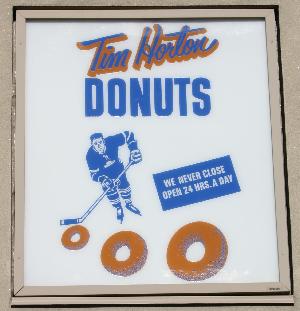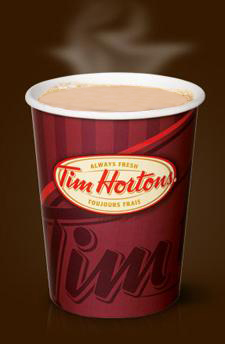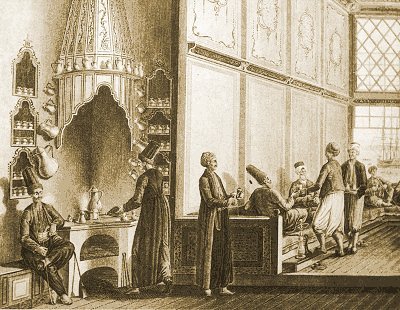Course:HIST104/Double Double
The Double-double is a coffee served at Tim Hortons with two servings of cream and two of sugar. But the double-double is more than just a cup of coffee; it is a cultural artifact that has been molded into its current form by myriad historical and cultural forces. The following project seeks to briefly trace these forces through the ingredients that make up this cultural artifact, in order to map out the historical shifts and cultural contacts that have brought us the Tim Hortons double-double.
Tim Hortons
On May 17, 1964, Toronto Maple Leafs star defenceman Tim Horton and Toronto businessman Jim Charade opened the first Tim Horton Donut Shop. It was located in Hamilton, Ontario and offered a simple menu of drip coffee, tea, and 50 varieties of donuts served 24 hours a day, 7 days a week. The shop catered to Hamilton steel workers coming off shift, and hot, fresh donuts were made at least twice in each 24 hour period to coincide with their shift changes.[1][2] Tim Hortons began to expand their menu as the franchise spread throughout Canada; the present day Tim Hortons menu includes sandwiches, soups, chillies, bagels, muffins and specialty coffees.
The first U.S. store was opened in 1984, in Tonawanda, NY. Tim Hortons has since expanded into Connecticut, Indiana, Kentucky, Maine, Massachusetts, Michigan, Ohio, Pennsylvania, Rhode Island and West Virginia.[3] In 1977, Tim Hortons established a separate training centre to ensure consistency throughout the chain's stores. This was a significant change in the approach to training coffee shop franchisors within Canada; previously all training had been conducted in the stores themselves.[4]

In 2002, Tim Hortons had $2.5 billion in sales, surpassing McDonald's revenues of $2.28 billion.[6] On April 4th 2010, there were 3,029 in Canada and 567 in the United States. [3]
Company Timeline
- 1964: First Tim Horton Donut Shop opens in Hamilton, ON
- 1965: Ron Joyce buys the first Tim Hortons franchise
- 1967: Joyce and Horton become full partners
- 1974: In February, Tim Horton dies in tragic car crash
- 1975: 1st Tim Horton Children's Foundation camp opens in Parry Sound, ON
- 1985: 1st U.S. store opens in Amherst, NY
- 1991: 500th Canadian store opens in Aylmer, QQ
- 1995: Tim Hortons is purchased by Wendy's International Inc.
- 1998: 100th U.S. store opens in Columbus, OH
- 2001: 1st U.S. Tim Horton Children's Foundation camp opens in Campbellsville, KY
- 2006: Tim Hortons is fully spun off as a separate company as of September 29, 2006.
- 2006: 3000th store in the chain opens in Orchard Park, NY
- 2008: 500th U.S. store opens in Detroit, MI
- 2009: Tim Hortons Inc. completes reorganization and becomes a Canadian public company.[3]
"Welcome to Canada"

Tim Hortons proudly displays and capitalizes on its Canadian heritage. The connection between Canada's national past time, hockey, and Tim Hortons has been central to the brand from the company's beginnings. In the early days of the franchise an appearance by its namesake was the main draw when a new location opened its doors.[2] This connection continues through the Timbits Minor Hockey program, a charitable organization run by Tim Hortons that "works with local hockey associations in communities across Canada and the US to help by providing player jerseys, participation medals and hockey Jamborees to over 50,000 players a year."[7]
Much of Tim Hortons' advertising centres around Canadian nationalism, and the company makes an obvious effort to position the double-double—and their coffee in general—as the quintessential Canadian beverage. In "Welcome Home" (included below) Tim Hortons coffee is depicted as being as Canadian as snow. These "True Stories" ads are loosely based on the Tim Hortons run website http://www.everycup.ca, where customers are encouraged to share their personal "Tim Hortons stories."[8]
Corporate positioning of the double-double as the iconic Canadian drink is not completely one sided. The company recently opened a location in Kandahar, Afghanistan at the request of the Canadian military, and—according to employee Jennifer Jones—the double-double mythos travels: "we can often tell what someone will order just by looking at the uniform. The Canadian troops usually just want a double-double, known as a NATO Standard over here."[9] In 2004, the Canadian Oxford Dictionary added an entry for the double-double, basing this inclusion on the fact that the term is no longer used solely by Tim Hortons employees, but is now part of the Canadian lexicon.[10] Canadian writer Pierre Berton sums up the chain's Canadian-ness as follows: "in so many ways the story of Tim Hortons is the essential Canadian story. It is a story of success and tragedy, of big dreams and small towns, of old-fashioned values and tough-fisted business, of hard work and of hockey."[11]
Ingredients
Coffee
The coffee beans used to make a double-double are a “blend of 100% Arabica beans”[12] grown in South America; specifically Guatemala, Brazil, Colombia, Honduras, and El Salvador.[13] The origin of these coffee trees can be traced to Ethiopia, where they have been cultivated for at least a millenia and most likely closer to two. In those earlier times the fruit of coffee trees was ingested in various forms, but it wasn’t until the 15th century that the beans of the tree were first roasted, ground, and made into an infusion—and modern coffee was born.[14][15]
Knowledge of the coffee bean and the dark, potent, inspiring elixir that can be produced from it spread from Ethiopia to Arabia, and then on to Europe and the rest of the world. Early on the drink was used for religious and medicinal purposes. Early Sufi mystics used coffee to stave off drowsiness during late night prayers. Coffee also helped digestion. During the 15th century the drink transitioned into everyday use, and soon coffeehouses were all the rage throughout the Islamic world.[16][17][18]
The rise of the coffeehouse during the 16th century in Arabia paralleled the rising importance of coffee as a social institution, providing an alternative social space for people to come together. The coffeehouse was secular, open to most men regardless of class, and offered an alternative to the debilitating effects of alcohol. It was during the later half of the 17th century that coffee and coffeehouse culture spread to Europe.[19][20]
By the middle of the 18th century coffee trees had spread to five continents. This spread was greatly aided by European colonialism, and was spurred on by an effort to satiate a rising global demand for coffee. Coffee beans in turn became a major commodity helping to provide the super-profits needed to fuel European imperial expansion. Another major commodity of the time was tea. However, due to a boycott of tea by British colonial subjects who were discontent with certain British taxation practices, coffee became the beverage of choice throughout North America. This provided the cultural space necessary for the Tim Hortons double-double.[21][22]
Sugar
Sugarcane, the grass variety that is processed and refined to create the two heaping teaspoons of white sucrose granules that sweeten a Tim Hortons double-double, likely originated in Polynesia. The significance of the plant is revealed in South Pacific legend, which tells variations of a story in which sugarcane sprouted a woman and a man who, through their offspring, founded the human race.[23]
The plant was first domesticated in New Guinea and Indonesia, and later spread to India by way of travelers who carried varieties of the plant to tropical climates around the globe. Indian hymns from the Vedic-period make reference to the plant, and in approximately 325 B.C.E. an Indian government official refers to five kinds of sugar (including khanda, the etymological root of the word candy). It then made its way to China, where manufacture of sugarcane dates back to references made in 286 B.C.E. Chinese Buddhism taught of the healing properties of the plant, and knowledge of sugarcane spread alongside the religion. Egypt grew sugarcane from the mid-8th century C.E., and by the 10th century it had become an important Middle Eastern crop. Arab expansion then spread the plant throughout the Mediterranean.[24]
Once it found its way to Europe, processed sugar was an extremely rare luxury item. In the 13th century it was so rare that when England's King Henry III ordered three pounds of it, he added "if so much of it is to be had." By the 14th century there was more of the stuff to go around, and Venetian traders began exporting larger amounts. This sugar remained prohibitively expensive, and was mostly used to make foul tasting medicines more palatable. [25]
Indulgent sugar consumption started in earnest when royal and noble courts in Persia, Islamic North Africa, and Europe began decorating their feast tables with elaborate sculptures made from sugar.[26] Between 1350 and 1500 the cost of ten pounds of sugar dropped from 35% of an ounce of gold to 8.7%, and by the 16th century a burgeoning European merchant class had taken up the noble habit of adorning their tables with edible art.[27] By the mid-16th century sugar finally made its way onto middle class tables, replacing honey as the primary sweetener for tea and coffee.[28] By the mid-19th century sugar consumption in Britain had rocketed to half a pound per person, per week.[29]
Mass production of sugar was a labour-intensive process. As demand for sugar increased, the slave labour that colonial societies used to produce this commodity on a large scale expanded in turn. As such, the history of the consumption of sugar is inextricably tied up with the history of transatlantic slavery.[30] The sugar consumed in present day Canada reflects this colonial heritage; our sugar continues to be grown mainly in South and Central America, Australia and the Caribbean. Canadian sugar refineries purchase a partially processed form of sugarcane from these regions, and after refining it further sell it in local Canadian markets.[31]
Cream
In modern day North America most dairy products come from cows, and as such "cream" is synonymous with "cow's cream." The use of cattle as providers of milk dates back to the fourth millennium B.C.E., in the ancient civilizations of Egypt and Mesopotamia.[32] The practice of dairying likely spread from these centres, but it is possible that it may have also arisen independently in Northern Europe. Large areas of central Africa and eastern Asia have no tradition of milk consumption, and many adults in these areas are unable to digest fresh milk due to lactose intolerance. The ability to absorb lactose is thought to have evolved over a long period of time, and this adaptation simply did not occur in those areas where milking was uncommon.[33] Britain has a long history of milk consumption; Julis Ceasar wrote of the British: lacte et carne vivant (they live on milk and meat).[34] The current Canadian custom of drinking tea and coffee with milk or cream can be traced back to Britain.
The British originally drank both coffee and tea "black," but by the 18th century the British had begun adding milk and cream to their coffee in order to soften its bitterness.[35] Although it may be more fable than fact, the Austrians are often credited with starting the fashion of adding dairy to coffee. Legend has it:
Franz George Kolschitzky, who acted as a spy for the Austrian army defending Vienna against the Turks in 1683, was rewarded with sacks of coffee left by the invaders and permission to open the first coffee-house; finding that his customers disliked the strong Turkish coffee with a heavy sediment, he strained it and added milk and honey or sugar, so establishing the popularity of Viennese coffee.[36]
The Canadian cream diluting a Tim Hortons double-double is procured from Canada's 1.4 million dairy cattle, 92% of which are of the Holstein breed.Cite error: Invalid <ref> tag; invalid names, e.g. too many
References
- ↑ Buist, Ron (2003). Tales From Under the Rim: The Marketing of Tim Hortons. Fredericton, NB: Goose Lane Editions, p.36.
- ↑ 2.0 2.1 Joyce, Ron (2006). Always Fresh: The Untold Story of Tim Hortons by the Man Who Created a Canadian Empire. Toronto: HarperCollins Publishers Ltd., p.35.
- ↑ 3.0 3.1 3.2 "The History of Tim Hortons". Tim Hortons. Retrieved 2010-07-23. Cite error: Invalid
<ref>tag; name "Hortons" defined multiple times with different content - ↑ Penfold, Steve (2008). The donut: a Canadian history. University of Toronto Press, p.121.
- ↑ Buist (2003), p.50.
- ↑ Harris, Rebecca (7 February 2005). "Marketer of the Year: Down-Home Smarts". Marketing Magazine. Archived from the original on 2007-09-27.
- ↑ 7.0 7.1 "Sidney Crosby promotes fun with Timbits Minor Hockey". Tim Hortons. Retrieved 2010-07-29.
- ↑ "Every Cup Tells a Story". Tim Hortons. Retrieved 2010-07-29.
- ↑ "Tim Hortons in Kandahar, Afghanistan: An insider's view". Canadian Living Magazine. Retrieved 2010-07-30.
- ↑ "'Double-double'? Now you can look it up". CBC. Retrieved 2010-07-29.
- ↑ "Investing in an icon: Why everyone wants a piece of Tim Hortons". Ottawa Citizen. Retrieved 2010-07-30.
- ↑ Tim Hortons FAQ Retrieved on 2010-07-23.
- ↑ Tim Hortons Coffee Partnership Retrieved on 2010-07-23.
- ↑ Hattox, Ralph S. (1996) Coffee and Coffeehouses: The Origins of a Social Beverage in the Medieval Near East. Seattle: University of Washington Press. p. 13.
- ↑ Pendergrast, Mark (1999) Uncommon Grounds: The History of Coffee and How It Transformed Our World. New York: Basic Books. p. 3-5.
- ↑ Ellis, Markman (2004) The Coffee House: A Cultural History. Great Britain: Weidenfeld & Nicolson. p. xi-xiii.
- ↑ Hattox (1996) p. 13-14
- ↑ Pendergrast (1999) p. 6-7
- ↑ Ellis (2004) p. xi-xiii.
- ↑ Pendergrast (1999) p. 7-8
- ↑ Pendergrast (1999) p. 17-20
- ↑ Wild, Antony (2004) Coffee: A Dark History. Great Britain: HarpersCollinsPublishers. p. 134-6.
- ↑ Abbott, Elizabeth (2008). Sugar: A Bittersweet History. Toronto: Penguin Canada, p.12.
- ↑ Abbott (2008), pp.12-3.
- ↑ Abbott (2008), p.20.
- ↑ Abbott (2008), p.21.
- ↑ Abbott (2008), p.22-3.
- ↑ Abbott (2008), p.46.
- ↑ Abbott (2008), p.66.
- ↑ Musgrave, Toby & Will (2000). An Empire of Plants: People and Plants that Changed the World. New York: Sterling Publishing Co., p.37.
- ↑ "Canadian Sugar Industry". Canadian Sugar Institute. Retrieved 2010-07-29.
- ↑ Clutton-Brock, Juliet (1999). A Natural History of Domesticated Animals. Cambridge UP, p. 81.
- ↑ Clutton-Brock (1999), p. 82.
- ↑ Burnett, John (1999). Liquid pleasures: a social history of drinks in modern Britain. Routledge, p.29.
- ↑ Burnett (1999), p.30.
- ↑ Burnett (1999), p.207.



